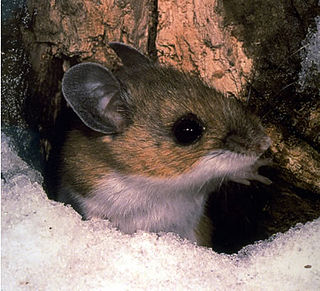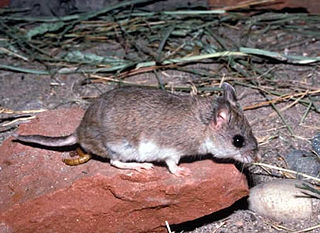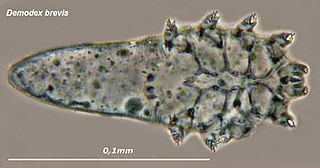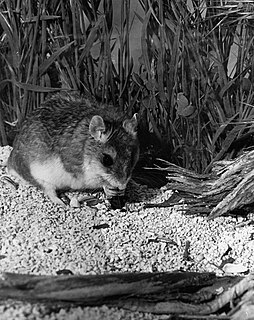
Mange is a type of skin disease caused by parasitic mites. Because mites also infect plants, birds, and reptiles, the term "mange" or colloquially "the mange", suggesting poor condition of the hairy coat due to the infection, is sometimes reserved only for pathological mite-infestation of nonhuman mammals. Thus, mange includes mite-associated skin disease in domestic animals, in livestock, and in wild animals. Since mites belong to the arachnid subclass Acari, another term for mite infestation is acariasis.

Demodicosis, also called demodectic mange or red mange, is caused by a sensitivity to and overpopulation of Demodex spp. as the host's immune system is unable to keep the mites under control.

An eyelash or simply lash is one of the hairs that grows at the edge of the eyelid. It grows in one layer on the edge of the eyelids. Eyelashes protect the eye from debris, dust and small particles and perform some of the same functions as whiskers do on a cat or a mouse in the sense that they are sensitive to being touched, thus providing a warning that an object is near the eye.

Demodex is a genus of tiny mites that live in or near hair follicles of mammals. Around 65 species of Demodex are known. Two species live on humans: Demodex folliculorum and Demodex brevis, both frequently referred to as eyelash mites, alternatively face mites or skin mites. Different species of animals host different species of Demodex. Demodex canis lives on the domestic dog. The presence of Demodex on mammals is common and usually does not cause any symptoms, although occasionally some skin diseases can be caused by the mites. Demodex is derived from Greek δημός dēmos "fat" and δήξ dēx, "woodworm".

The Neotominae are a subfamily of the family Cricetidae. They consist of four tribes, 16 genera, and many species of New World rats and mice, predominantly found in North America. Among them are the well-known deer mice, white-footed mice, packrats, and grasshopper mice.

Mearns's grasshopper mouse or the Chihuahuan grasshopper mouse is a grasshopper mouse found in southwestern New Mexico, West Texas, and north-central Mexico. They are similar to Onychomys torridus, but differ in karyotype and size. This mouse is smaller in every regard except for the nasal length of the skull.

Demodex folliculorum is a microscopic mite that can only survive on the skin of humans. Most people have D. folliculorum on their skin. Usually, the mites do not cause any harm, and are therefore considered an example of commensalism rather than parasitism. If D. folliculorum does cause disease, this is known as demodicosis.

The southern grasshopper mouse or scorpion mouse is a species of predatory rodent in the family Cricetidae, native to Mexico and the states of Arizona, California, Nevada, New Mexico, and Utah in the United States. Notable for its resistance to venom, it routinely preys on the highly venomous Arizona bark scorpion.

The northern grasshopper mouse is a North American carnivorous rodent of the family Cricetidae. It ranges over much of the western part of the continent, from southern Saskatchewan and central Washington to Tamaulipas in northeast Mexico.

Demodex brevis is one of the two species of face mite that inhabit humans. They are very similar to Demodex folliculorum, with just a few differences. They are usually found in the sebaceous glands of the human body. The same way that D. folliculorum reproduces in the follicles, D. brevis reproduces in the sebaceous glands. Under normal conditions they are not harmful, and are considered to be commensals rather than parasites or symbionts. During a severe infestation, though, there may be adverse effects on the host, such as demodicosis.

Grasshopper mice are rodents of the genus Onychomys, occurring in North America. They feed on insects and other arthropods.
Demodex injai is a hair follicle mite in the domestic dog.
Demodex bovis, also known as the cattle follicle mite, usually causes demodicosis, or demodectic mange, in cattle. This disease is common in tropical areas and is not usually found in temperate environments. Demodicosis is characterized by the formation of papules and nodules over the cattle's skin. These lesions most commonly occur on the neck, shoulders, and armpit of cattle; however, sometimes they also appear on the udder. This condition is often found in cattle with increased stress from pregnancy or lactation. Natural and acquired immunity can cause a decrease in the number of mites infesting a cow, as well as decreasing the severity of a cow's symptoms.
Demodex conicus is a hair follicle mite found in the ear canal of the house mouse, Mus musculus.
Demodex criceti is a hair follicle mite found in the epidermis of the Syrian hamster, Mesocricetus auratus.
Demodex gatoi is a hair follicle mite from the skin surface of the domestic cat, Felis silvestris. It is the second described species of Demodex from the domestic cat, and is distinguishable from Demodex cati by being shorter and rounder.
Demodex gapperi is a hair follicle mite found in the eyelids of the red-backed vole, Clethrionomys gapperi.
Demodex huttereri is a hair follicle mite found in the Meibomian glands of the striped field mouse, Apodemus agrarius.
Demodex ponderosus is a hair follicle mite found on thinly haired regions of the brown rat, Rattus norvegicus.
Demodex foveolator is a hair follicle mite found in epidermal pits of the lesser white-toothed shrew, Crocidura suaveolens.









